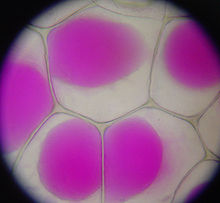Plasmolysis: Difference between revisions
m Reverted edits by 90.194.111.159 (talk) to last version by Adrian J. Hunter |
No edit summary |
||
| Line 1: | Line 1: | ||
{{unreferenced|date=July 2006}} |
{{unreferenced|date=July 2006}} |
||
[[Image:Turgor pressure on plant cells diagram.svg|thumb|300px|right|Plant cell under different enviroments]][[Image:Rhoeo Discolor epidermis.jpg|left|thumb|Before plasmolysis...]][[Image:Rhoeo Discolor - Plasmolysis.jpg|thumbnail|right|...and after.]] |
[[Image:Turgor pressure on plant cells diagram.svg|thumb|300px|right|Plant cell under different enviroments]][[Image:Rhoeo Discolor epidermis.jpg|left|thumb|Before plasmolysis...]][[Image:Rhoeo Discolor - Plasmolysis.jpg|thumbnail|right|...and after.]] |
||
| ⚫ | |||
| ⚫ | |||
Revision as of 15:05, 1 February 2008



Alexia is an effect of osmosis in plants. Osmosis is the net diffusion of water across a selectively permeable membrane, such as a cell membrane, from an area with a high water potential to an area with a low water potential.
Turgidity
It has been suggested that this article be merged with Turgor pressure and Talk:THIS PAGE#Merger proposal. (Discuss) Proposed since September 2007. |
A plant cell in a more dilute salt solution will absorb water by endosmosis, so that the increased volume of water in the cell will increase pressure, making the protoplasm push against the cell wall, a condition known as turgor. Turgor makes plant cells push against each other in the same way and is the main method of support in non-woody plant tissue. Plant cell walls resist further water entry after a certain point, known as full turgor, which stops plant cells from bursting as animal cells do in the same conditions.
Plasmolysis
If a plant cell is placed in a more concentrated salt (hypertonic) solution, it loses water and hence turgor pressure, making it flaccid. Plants with cells in this condition wilt. Further water loss causes plasmolysis: pressure decreases to the point where the protoplasm of the cell peels away from the cell wall, leaving gaps between the cell wall and the membrane. Eventually cytorhysis – the complete collapse of the cell wall – can occur. There is no mechanism in plants to prevent excess water loss in the same way as excess water gain, but plasmolysis can be reversed if the cell is placed in a weaker solution. The equivalent process in animal cells is called crenation. The liquid content of the cell leaks out due to diffusion.
Plasmolysis only occurs in extreme conditions and rarely happens in nature. It is induced in the laboratory by immersing cells in strong saline or sugar solutions to cause exosmosis, often using Elodea plants or onion epidermal cells, which have coloured cell sap so that the process is clearly visible.
See also
Sources
- Longman GCSE Biology by Phil Bradfield and Steve Potter
External links
- Pictures of plasmolysis in Elodea and onion skin
- Wilting and plasymolysis
